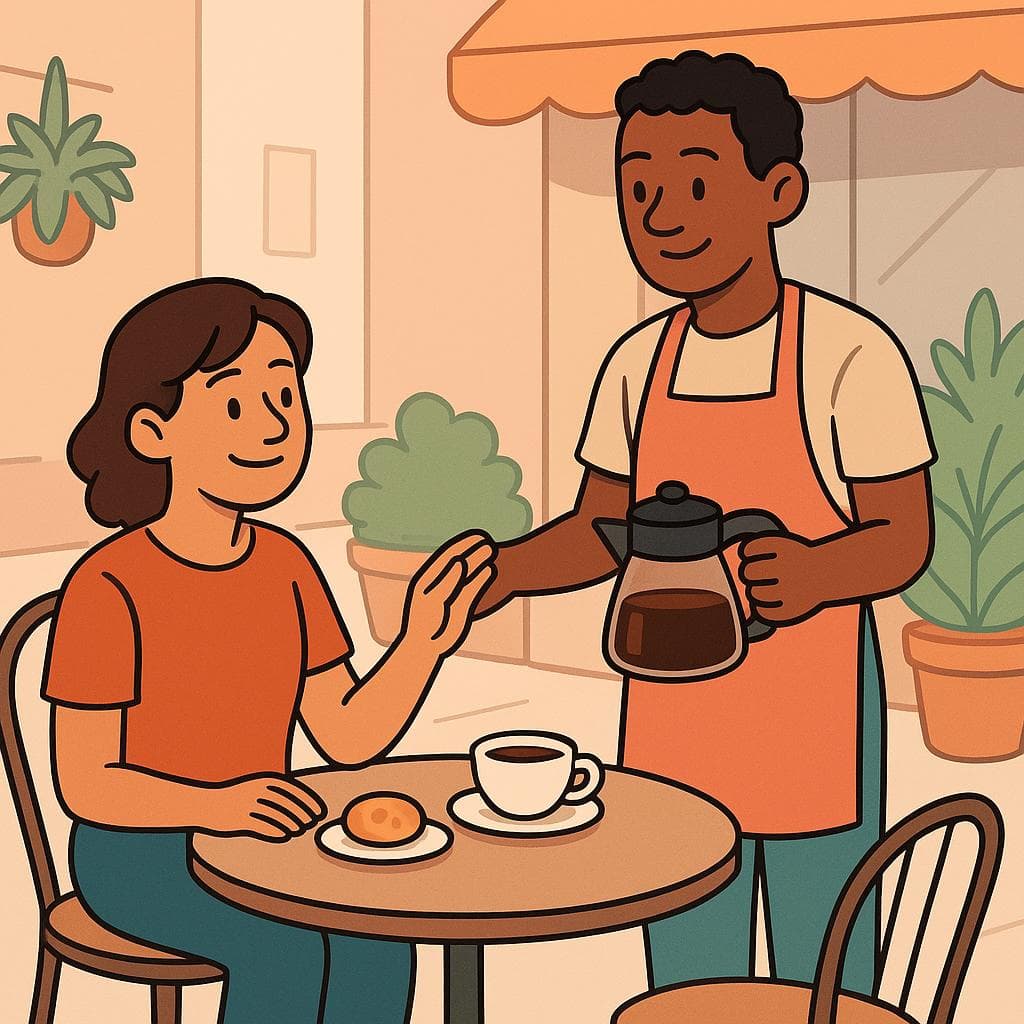Yes, please
in SpanishSí, por favor
/SEE, por fah-VOR/
This is the most direct, polite, and universally understood way to say 'Yes, please' in Spanish. It's your go-to phrase that works in almost any situation, from casual to very formal.

Saying 'Sí, por favor' is the perfect polite response when accepting an offer, like more coffee from a waiter.
💬Other Ways to Say It
Sí, gracias
/SEE, GRAH-see-ahs/
Literally 'Yes, thank you.' This is extremely common when accepting something that is offered to you, like food, a drink, or a helpful item. It combines acceptance and gratitude in one smooth phrase.
Claro que sí
/KLAH-roh keh SEE/
A warm and enthusiastic way to say 'Of course!' or 'Yes, definitely!' It adds a friendly and positive emphasis to your 'yes'.
Claro
/KLAH-roh/
The short version of 'Claro que sí', this just means 'Of course' or 'Sure'. It's a very common, quick, and casual way to agree to something.
Por supuesto
/por soo-PWES-toh/
This also means 'Of course' or 'Certainly', but it carries a more formal and definitive tone than 'claro'. It sounds confident and polite.
Sí, con gusto
/SEE, kon GOOS-toh/
This means 'Yes, with pleasure.' It's a very warm, polite, and slightly more formal way to accept an offer or agree to a request. It shows you're happy to do it.
Sí, me encantaría
/SEE, meh en-kahn-tah-REE-ah/
This translates to 'Yes, I'd love to.' It's the perfect response for accepting invitations to events, parties, or activities.
Vale
/BAH-leh/
This is the Spanish equivalent of 'Okay' or 'Alright'. While not a direct translation of 'yes please', it's used constantly in Spain to agree to suggestions or plans.
Dale
/DAH-leh/
Similar to 'Vale' in Spain, 'Dale' is the go-to word for 'Okay', 'Go for it', or 'Sure' in the Southern Cone of South America. It's very versatile.
🔑Key Words
Key Words to learn:
📊Quick Comparison
Here's a quick guide to help you choose the best way to say 'Yes, please' based on the situation.
| Phrase | Formality | Best For | Avoid When |
|---|---|---|---|
| Sí, por favor | Neutral | Almost any situation; it's the universal and safe choice. | Never wrong, but can be replaced by warmer options with friends. |
| Sí, gracias | Neutral | Accepting a concrete offer, like a cup of coffee or a piece of cake. | Making a request yourself (use 'por favor' instead). |
| Claro que sí | Informal | Showing enthusiasm and friendliness with peers or in casual settings. | Very formal business meetings or solemn occasions. |
| Por supuesto | Formal | Professional environments or showing respectful agreement. | Casual chats with close friends, where it might sound a bit stiff. |
📈Difficulty Level
Generally easy for English speakers. The only slight challenge is the soft, tapped 'r' sound at the end of 'favor', which is different from the hard English 'r'.
This is a fixed phrase with no grammatical complexity. You don't need to change it based on who you're talking to.
While the main phrase is simple, choosing between the variations ('claro', 'por supuesto', 'sí, gracias') involves some social awareness, but it's not difficult to pick up.
Key Challenges:
- Remembering to use 'por favor' consistently.
- Knowing the subtle difference between when to use 'Sí, por favor' vs. 'Sí, gracias'.
💡Examples in Action
— ¿Quiere un poco más de vino? — Sí, por favor.
— Would you like a little more wine? — Yes, please.
— ¿Necesitas ayuda con esas bolsas? — ¡Claro que sí, gracias!
— Do you need help with those bags? — Yes, of course, thank you!
— ¿Podemos confirmar su asistencia para la reunión de mañana? — Por supuesto, allí estaré.
— Can we confirm your attendance for tomorrow's meeting? — Of course, I'll be there.
— Mamá, ¿me das permiso para ir a la fiesta de Ana? — Sí, con gusto, pero vuelve antes de la medianoche.
— Mom, can I have permission to go to Ana's party? — Yes, with pleasure, but be back before midnight.
🌍Cultural Context
The Power of 'Por Favor'
Using 'por favor' (please) and 'gracias' (thank you) is extremely important in Spanish-speaking cultures, often more so than in English. Adding 'por favor' to any request is standard politeness and leaving it out can make you sound demanding or rude, even if that's not your intention.
'Sí, por favor' vs. 'Sí, gracias'
While both are used to accept something, there's a subtle difference. 'Sí, por favor' is best for when you are requesting something or accepting an offer *before* you receive it. 'Sí, gracias' is perfect for accepting an offer as it's being presented, combining the 'yes' and 'thank you' into one polite package.
Enthusiasm is Welcome
In many Spanish-speaking cultures, responding with warmth and enthusiasm is common and appreciated. Using phrases like '¡Claro que sí!' or '¡Me encantaría!' in informal situations can make interactions feel friendlier and more genuine than a simple 'sí'.
❌ Common Pitfalls
Forgetting 'Por Favor'
Mistake: "Just saying 'Sí' or 'Quiero un café' (I want a coffee)."
Correction: Always try to add 'por favor'. 'Sí, por favor.' or 'Quiero un café, por favor.'
Using 'Por Favor' After Receiving Something
Mistake: "A waiter gives you your drink and you say, 'Sí, por favor.'"
Correction: Say 'Gracias' once you have the item.
Using Regional Slang Everywhere
Mistake: "Using 'Vale' in Mexico or 'Dale' in Spain."
Correction: Stick to universal words like 'Claro' or 'Sí' if you're unsure of local slang.
💡Pro Tips
Match the Formality
Pay attention to how people speak to you. If someone uses the formal 'usted' and phrases like 'por supuesto', it's a good idea to respond with similar politeness. If they're using 'tú' and 'claro', you can be more casual.
Combine with a Smile
Non-verbal communication is key. Saying 'Sí, por favor' with a warm smile and a nod makes your response much more effective and friendly. Your tone of voice matters just as much as the words you choose.
When in Doubt, Use 'Sí, por favor'
If you're ever unsure which variation to use, 'Sí, por favor' is your safest bet. It is never wrong, never too formal or too informal, and always polite. It's the perfect default.
🗺️Regional Variations
Spain
'Vale' is the quintessential Spanish word for 'okay' or 'alright'. It's used constantly in informal contexts to agree to things, far more than in Latin America. You'll hear it dozens of time a day.
Mexico
Mexicans often use very polite and slightly more elaborate phrasing. 'Sí, cómo no' (Yes, why not) is a common polite affirmative. 'Ándale pues' is a very friendly, informal way to agree to a plan.
Argentina & Uruguay
'Dale' is the Argentinian 'Vale'. It's the standard, all-purpose informal agreement for plans, suggestions, and requests. 'Obvio' for 'obviously' is also extremely common as an affirmative.
📱Texting & Social Media
Sí, por favor
WhatsApp, social media comments, casual chats.
¿Nos vemos en el cine? si porfa!
See you at the movies? yes please!
Sí
Used informally among friends, similar to saying 'yep!' or 'yuppers'.
¿Trajiste el libro? Sipi
Did you bring the book? Yep
💬What Comes Next?
After you accept an offer with 'Sí, por favor.'
Aquí tiene.
Here you go.
Gracias.
Thank you.
You agree to a friend's plan with '¡Claro que sí!'
¡Genial!
Great!
Entonces, ¿a qué hora?
So, what time?
🧠Memory Tricks
This visual connects the sound of the words ('See', 'por'/'pour') with the action of politely receiving something (a 'favor').
🔄How It Differs from English
In many English-speaking cultures, especially in casual contexts, it's common to drop 'please' and just say 'Yes' or 'Sure'. In Spanish, consistently adding 'por favor' is the norm and is essential for sounding polite. The line between 'Yes, please' and 'Yes, thank you' is also more distinct in Spanish, with 'Sí, gracias' being a very common way to accept an offer.
Spanish can be both more direct in its grammar but more indirect in its social norms. Using politeness markers like 'por favor' is a non-negotiable part of softening direct requests to maintain social harmony.
False Friends & Common Confusions:
Why it's different: While grammatically correct, a lone 'Sí' can sound blunt or dismissive in Spanish, especially when responding to an offer from someone you don't know well.
Use instead: Soften your 'Sí' by adding 'por favor', 'gracias', or by using a friendlier alternative like 'Claro'.
🎯Your Learning Path
➡️ Learn Next:
How to say 'No, thank you'
It's the natural counterpart to 'Yes, please' and equally essential for polite conversation.
How to say 'You're welcome'
This completes the basic politeness cycle: request, receive, thank, and respond.
How to say 'Can I have...?'
Once you can accept things, the next step is learning how to politely ask for them.
How to say 'Excuse me'
Another core polite expression needed for navigating daily life and getting someone's attention.
✏️Test Your Knowledge
💡 Quick Quiz: Yes, please
Question 1 of 3
A waiter at a restaurant comes to your table and asks, '¿Desea más agua?' (Would you like more water?). What is the most standard, polite response?
Frequently Asked Questions
What's the real difference between 'Sí, por favor' and 'Sí, gracias'?
Think of it this way: 'Sí, por favor' is for accepting an offer or making a request *before* it happens ('Would you like coffee?' -> 'Sí, por favor'). 'Sí, gracias' is perfect for accepting something *as* it's being handed to you, blending the 'yes' and 'thank you' into one. Both are polite, but this subtle distinction will make you sound more natural.
Is it ever okay to just say 'Sí'?
Yes, but mostly in very casual, fast-paced conversations with friends or family, or when answering a simple yes/no question that isn't an offer (e.g., '¿Viste la película?' -> 'Sí'). When accepting something, it's always safer and more polite to add 'por favor' or 'gracias'.
How do I say 'Yes, of course!' in a formal vs. informal way?
For an informal, friendly 'Of course!', use '¡Claro!' or '¡Claro que sí!'. For a more formal or professional situation where you want to say 'Certainly' or 'Of course', 'Por supuesto' is the perfect choice. It conveys confidence and politeness.
What if I want to say 'Yes, I'd love to!' to an invitation?
The best phrase is '¡Sí, me encantaría!'. It's enthusiastic and warm, and it perfectly communicates that you're excited about the invitation to a party, dinner, or event.
I hear 'vale' and 'dale' a lot. Can I use them anywhere?
It's best not to. 'Vale' is a hallmark of Spanish from Spain, while 'dale' is characteristic of Argentina and nearby countries. Using them outside of those regions can sound out of place. Stick with the universal 'claro' or 'sí' for informal agreement if you're not sure.
Can I use 'con gusto' to say 'you're welcome'?
Yes, absolutely! While 'Sí, con gusto' means 'Yes, with pleasure' (when accepting), simply saying 'Con gusto' on its own is a very common and polite way to say 'You're welcome' or 'My pleasure' after someone thanks you. It's a great alternative to 'de nada'.
📚Continue Learning Spanish Phrases
Explore More Phrases in These Categories
Find similar phrases to expand your Spanish vocabulary:
Want to Learn More Spanish Phrases?
Browse our complete collection of Spanish phrases organized by situation, from basic greetings to advanced conversations. Perfect for travelers, students, and anyone learning Spanish.
View All Spanish Phrases →



